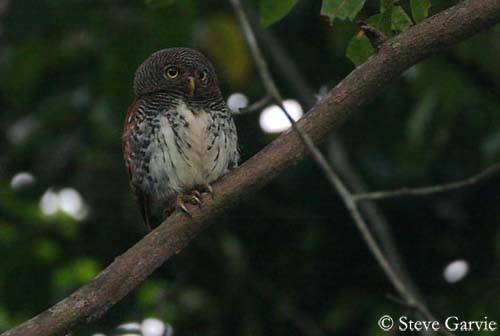
Chestnut-backed Owlet
Glaucidium castanotum
Strigiforme Order – Strigidae Family
BIOMETRICS :
Length : 19 cm
DESCRIPTION :
Chestnut-backed Owlet is a small, stocky owlet.
Adult male has barred black chestnut upperparts. Scapulars show two white vertical lines in some birds. Tail is dark brown barred black.
Underparts are white with black bars on breast and flanks. Lower throat is white. Upper breast is heavily barred black, almost forming a collar. Belly is shaft-streaked dark brown.
Fr : Chevêchette à dos marron
All : Kastanienmantelkauz
Esp: Mochuelo de Ceilán
Ital: Civettina dorsocastano
Nd: Ceylonese Dwerguil
Russe: Сычик буроспинный
Photographs by Steve Garvie
RAINBIRDER Photo galleries
Text by Nicole Bouglouan
Sources:
HANDBOOK OF THE BIRDS OF THE WORLD Vol 5 by Josep del Hoyo-Andrew Elliott-Jordi Sargatal - Lynx Edicions - ISBN: 8487334253
BirdLife International (BirdLife International)
Wikipedia (Wikipedia, The Free Encyclopedia)

The rounded head is dark grey, entirely barred black. Facial disk is brown, sometimes whitish in some birds.
Bill is dull greenish-yellow to horn-coloured, surrounded by numerous rictal bristles. Eyes are yellow. Legs are feathered whitish and black. Feet are yellow and partially feathered. Long claws are horn-coloured.
Both sexes are similar.
VOICE: SOUNDS BY XENO-CANTO
Chestnut-backed Owlet calls during the day, and gives far-carrying, repeated “krrraw krrraw krrraw…” while perched in dense foliage.
HABITAT:
Chestnut-backed Owlet inhabits wet dense forests, and can be seen from lowlands up to 1900/2000 metres of elevation.
This species is often seen at tops of tall trees on steep hillsides. It frequents gardens, wooded ravines and rubber plantations.
RANGE:
Chestnut-backed Owlet is endemic to Sri Lanka.
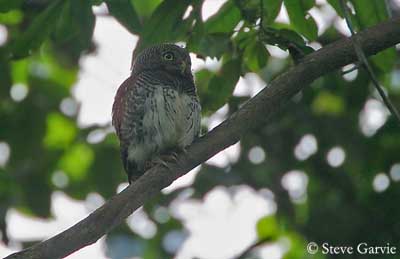
BEHAVIOUR:
Chestnut-backed Owlet is a diurnal species, very shy and wary, seldom seen.
It feeds mainly on insects (beetles), but also takes mice, lizards and small birds. It often hunts during the day.
During the nesting period, chicks are fed with larger preys.
Chestnut-backed Owlet is resident in its range. It is seen during the day, and particularly in late afternoon and at dusk.
It often perches in trees, watching around, searching for preys.
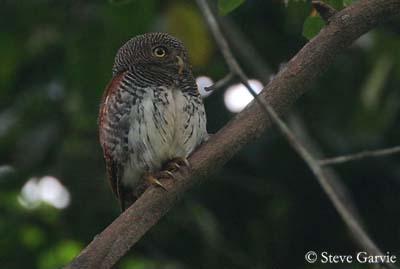
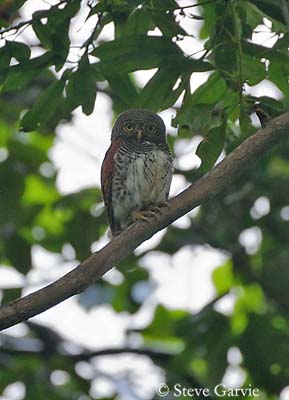
FLIGHT:
Chestnut-backed Owlet performs deep undulating flight.
REPRODUCTION:
Breeding season occurs from March to May.
Chestnut-backed Owlet nests in natural cavity in tree, sometimes in old Barbet or Woodpecker’s nest.
The eggs, usually two white eggs, are laid on the bare bottom of the cavity which is unlined.
Reproduction of this species is poorly known.
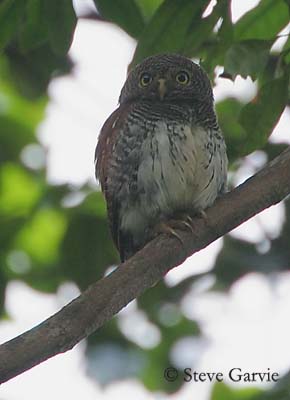
DIET:
Chestnut-backed Owlet feeds mainly on insects such as beetles. It also consumes mice, lizards and small birds.
PROTECTION/THREATS/STATUS:
Chestnut-backed Owlet is currently considered as NEAR THREATENED in its restricted range.
It is vulnerable to changes in the habitat due to deforestation, and frequents the forest remnants and Sinharaja Biosphere Reserve.